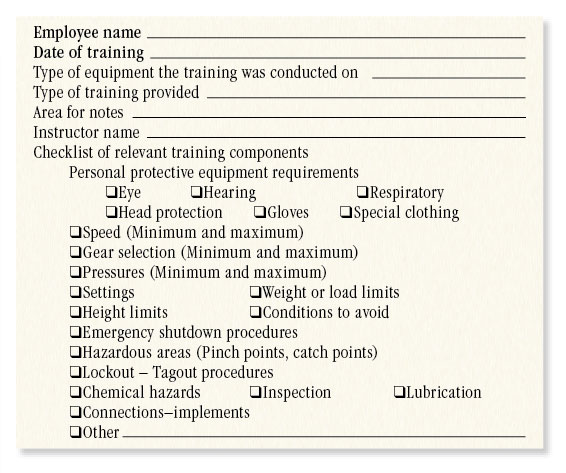Equipment safety training is one of the most crucial parts of your safety program. Since most equipment accidents are caused by operator error, it just can’t be understated. And unfortunately, most equipment accidents are serious, if not deadly. It’s hard to believe that tractor rollovers are still one of the leading killers on a farm.
An employee may be very knowledgeable, and have abundant experience, but do they understand how you want your equipment operated? Most all employees shine for the first few months, then they often revert back to their old ways. And most certainly, if you haven’t provided them with your safety and operational training, they will shine even less.
After the initial training, or what I call the New Employee Safety Training Orientation, employers must provide in-depth training relevant to the equipment the employee will be operating. Remember, if you’re not documenting it, you might as well not even be doing it!
The steps I recommend for training are:
- Show them how you want it done (always provide training materials)
- Test them on their knowledge (written, oral, or practical)
- Monitor their operation (supervisor observation)
- Document it (training form)
Show them how you want it done
People retain more from their training when they are physically shown what to do. This can be done though hands-on, video, pictures, or PowerPoint. Of course, nothing is better than hands-on. This is one of the only times that riders should be allowed on equipment, and only if it’s an enclosed cab. Training should be in-depth, and specific to the equipment they will be operating. I am a firm believer that you should always provide training materials, along with the training.
Test them on their knowledge
Once training has been provided, test them on their knowledge. I prefer written evaluations, mostly because it’s the best documentation of training and knowledge you can get. There is no better proof than a written evaluation. In my experience, oral is the least effective type of evaluation, unless it’s one-on-one, but it lacks documentation. A practical evaluation is a great way to find out how well they can operate the equipment, but it too lacks the documentation. And, you will be monitoring their operation in the next step anyway. A written review does not have to be 10 pages in length, but it needs to be in-depth. 10 specific questions is a good number, and in those questions you can easily test their retention. The more hazardous or technical the equipment, the longer and more in-depth the test. After the test has been completed, you should go over every question with the employee to review their answers and any corrections.
Monitor their operation
After they have received the training and have been tested, you need to monitor their operation. Most equipment, such as front-end loaders, tractors, stationary machinery, or other equipment, can be evaluated as they perform their actual duties. If it’s a hazardous type of equipment, like a forklift, you can make a course, or provide them with a task to perform. The monitoring of operation needs to be done by the instructor or a supervisor. Employee monitoring is not just a one-time deal; it should be ongoing as the employee settles in on their job tasks.

Document it
Document, document, document… An equipment training form is the best way to document the training. Here is an easy-to-make training form that can be made to meet the needs of most training documentation. I recommend the following information be on the form:
The information can be changed to better meet your training requirements. At the bottom of the form, there should be a location for signatures of the employees participating in the training.
Stay safe. PD
by Jary D. Winstead
www.worksafetyservices.com






